TRANSPORTATION IN THE DEVELOPING WORLD
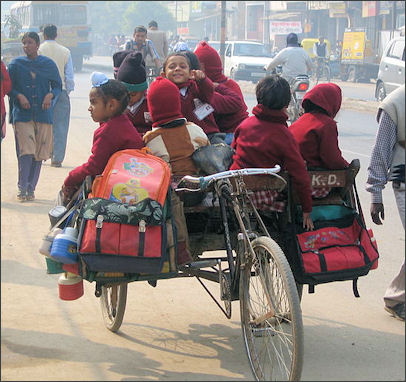
School-rickshaw in India Getting around is difficult in many parts of the developing world. Air transportation is expensive and sometimes dangerous; river travel is slow and unreliable; and overland travel is on potholed, rocky and rutted roads that are bone jarring in the dry season and turn to muck and goo during the wet season.
Many villagers are so poor they can't afford a horse, bicycle or motor scooter or the fare for a bus or truck ride, so if they have to go somewhere they walk. Some villagers ride so infrequently in vehicles that when they do it is not unusual for them to get car sick.
Errands often involve long walks and possessions are carried on their backs or heads or with primitive carts or maybe a donkey. One advantage with poverty is that villagers don't own much, and can't buy much, so they usually don't have very much to carry unless they are fetching water of firewood.
In some places people get around on tracks and foot paths and distance are measured based on walking time rather than in kilometers or miles. Even paved roads are used mainly for walking rather than driving.
In the cities, most people get around by public bus or shared taxi or on foot. City streets are dominated by a chaotic mix of cars, trucks, buses, pedestrians, bicycles, motorscooters, buses and other various kinds of motorized and non-motorized small vehicles. The number of cars and trucks is increasing everyday and some cities are already choking in exhaust fumes and traffic jams.
It is usually hard to get around in cities only by walking. Taxis are relatively cheap. Most small streets have no name; addresses refer to a series of concentric areas; and streets are sometimes numbered according to when they were built rather than their location in an area. Taxi drivers respond to landmarks not street numbers.
Bicycles and Motorcycles
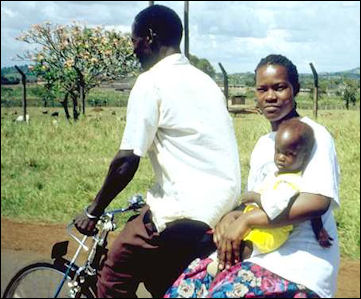
Bicycle taxi in Africa In some places bicycles and bicycle-like vehicles are the workhorses of the transportation system. Ordinary people use them to get around from place to place; farmers attach carts to them to move crops. Movers and merchants sometimes perform modern day miracles with their bicycles, carrying things like double beds, sofas, wardrobes and boxes of chickens, stacked eight feet high.
In some developing counties bicycles are regarded as a poor-man's vehicles. In the poorest countries they are often the only source of transportation other than walking. In some cases they cost the equivalent of a year’s salary and only relatively well off people can afford them.
Motor scooters are often the vehicle of choice in the cities. Entire families sometimes can ride together on little 60cc models. I once saw one with six people on it. A man was in the middle driving. A woman, presumably his wife, was in front of him and she was holding a small child who in turn was holding a baby. Some how there was still enough room in the back for the two other children to squeeze on.
The main problem with motorscooters is that they burn a mixture of oil and gasoline that produces more pollution than an American car.
Donating Bikes to the Developing World
Bikes for the World, a nonprofit group based in Arlington, Virgina, takes thousands of unwanted bikes in suburban Washington and sends them overseas to people who need them. Susan Svrluga wrote in the Washington Post, “Its founder, Keith Oberg, knows how much of a difference even one bike could make. In the developing world, bikes can transform lives — increasing the number of people a public-health nurse can treat, helping a farmer deliver his fruit to a better market or making it easier for a family to get clean drinking water. [Source: Susan Svrluga, Washington Post, July 28 2011]
Describing the story of one bike that ended up in Coroma, Costa Rica Svrluga wrote: “By the time Odily Sanchez Segura saw her bike for the first time, it had crossed a sea, sped through cities and mountains, and jolted over rough dirt roads deep into a reserve for an isolated tribe of native Costa Ricans. It had floated 40 minutes in a canoe along a river lined with plantain trees, and then, with several other bikes donated in suburban Washington, bounced miles over a jungle path to Coroma, a small village of thatch-roofed huts on stilts.
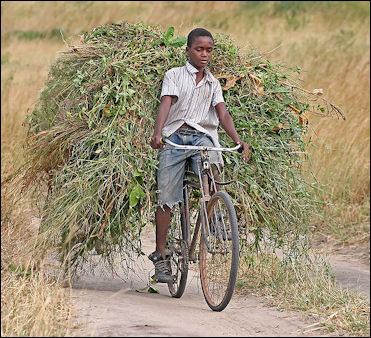
transporting fodder by bicycleOdily, who’s 10 years old and skinny...She and her 13-year-old brother would use the bike to get to school. They were two of the lucky ones in a place where people are without electricity, running water and, for the most part, any belongings at all, where many children can’t get an education because they live too far from the nearest school. Odily’s 15-year-old brother had to walk two hours each way to get to class.The bikes, she believes, will help take them there.
Three months earlier, Peter Rushford had pulled into a parking lot at Baileys Crossroads on a chilly March afternoon, swung open the back of his SUV and started unloading bikes that his family no longer wanted. There were six of them, including the bright green mountain bike that his 20-year-old daughter, Carly, had once ridden to swim-team practice.The bikes had been lying under the back porch of the Rushfords? cedar-shingle-and-stone home in Potomac near Congressional Country Club.
The Rushford bikes were eventually wedged with hundreds of others into a 40-foot-long shipping container. Oberg, 60, climbed onto the tower of sardined bikes to squeeze a box of extra pedals into a crevice and ease more children’s bikes in, wiggle by wiggle.As he worked, one of his two employees drove up with 28 bikes he had just scavenged from the dump. Some looked brand new,” Oberg said. “It’s amazing what people throw away.” Finally, the container was full to bursting: 507 bikes.
In Costa Rica Steven Fonseca Ortiz drove a diesel pickup loaded with the green mountain bike and five others from Washington through the crowded streets of San Jose, toward the mountains beyond still wrapped in mist. Fonseca, 21, works for the Fundacion Integral Campesina, a nonprofit group that works with Bikes for the World in Costa Rica. FINCA encourages people in rural areas to form collective banks with tiny amounts of capital, lending money so that someone can start a business.
Fonseca was delivering these bikes 150 miles to Talamanca,home to the Bribri and other indigenous people. Remote and sparsely populated, it is the poorest canton in Costa Rica. The average person has finished fourth grade.
Buses, Trains and Trucks
Most local people do their local and long distance traveling by bus, truck or train. Sometimes it seems that the passengers take all their worldly possessions with them. The aisles are filled with bundles, baskets of produce, and people standing or sitting on little stools.
When the buses and trains stop passengers are assaulted by women and children vendors selling snacks and drinks, who walk down the aisles of the trains or hawk their products outside the windows of the carriages.
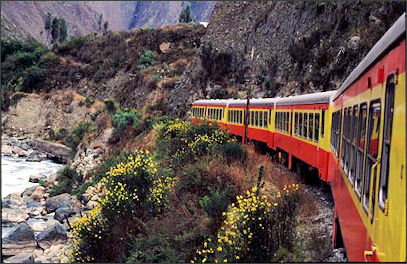
Train in Peru Buses in China vary in quality from company to company and route to route. There are oftem both private buses and government-run buses. The quality of the bus service often coincides with the quality of the road. As a rule the buses traveling between major cities are better than those servicing rural or mountainous areas. On well-beaten tourist routes there are often special buses for foreigners with air-conditioning and comfortable seats. Many local buses have scratchy, irritating music or video systems. Remember bring your food and water. The places the buses stop at ate sometimes pretty horrible.
Developing world buses are slow and they often breakdown. They can be a little scary and travelers have been injured and killed. The drivers pass on hills and blind corners and play chicken with the cars coming in the other direction.
Taxis and Minibuses run regular routes between towns and cities. With few private vehicles and bicycles only good or short hauls, minibuses have become the dominant form of transportation. Minibus drivers are reckless and the ticket collectors are rude and surely. Even though buses have a sign that lit their maximum capacity a 19, the carry 30. As a rule they service shorter hauls than buses and are fast but crowded. In some rural areas, however, they can be slow if a lot of stops are made and the bus has to wait a long tome for passengers to show up. The taxis can carry up to six people and the minibuses can seat 8 to 16 people with reasonable comfort. It is recommended that you go early to the place where the shared taxis and minibuses leave because generally that is when everybody sets off. Otherwise you might have to wait for a long time or pay a higher price to shove off with less people.
Trucks are often used by travelers to get around on tough roads in remote areas. Some are used specifically to carry passengers. Others are carrying something like bags of grain or empty coke bottles, and travelers have to sit on top of the whatever the cargo is. Most are dump-truck-size trucks with a flat open bed with a seven or eight foot wooden or metal fence around it, which passengers have to climb over to get in.
Pick up trucks are used to carry passengers in poor remote areas where no other forms of transportation are available. Some run regular routes at scheduled times, but most leave on a when full basis and pick up and drop off passengers along the road. Passengers sit in the back on uncomfortable benches lined up on the sides. Usually there is a compartment over the back to protect passengers from rain and wind. Pick-ups as a rule are very crowded, and uncomfortable and sometimes dangerous.
Rural Roads and Highways
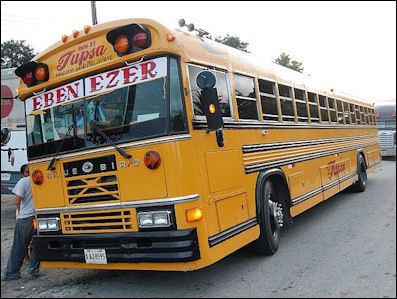
Guatemala Blue Bird
All-American Chicken bus Many rural roads are horrible. They have car-swallowing potholes, humongous ruts, knee-deep quagmires and long sections washed out by rains or covered with landslides. Vehicles often ford rivers at regular intervals and the roads themselves often become streams in the wet season. It is very easy to make a wrong turn because there are no road signs. Bad road prevents farmers from getting their crops to market and their children to clinics and hospitals.
Roads between the major cities are generally two-lane roads. There are not many multiple American-style highways but more and more are being built all the time. Many highways are dominated by fully loaded trucks that have to brake hard when they go downhill. New highways are often two lanes but they have shoulders that drivers often treat as passing lanes.. This is okay except when there is a disabled car on the shoulder on the other side of a tight turn.
Some roads have pavement sections that run only a few miles and then deteriorate into potholes, washboard ripples, dirt and rocks. Maps are often unreliable. Distances can be deceptive. Even on paved roads traffic is often slowed by potholes and slow trucks. A journey of a 100 miles through the mountains sometimes takes four or five hours.
Hunger today is often more the result of inadequate distribution and lack of infrastructure than lack of food or crops. Many villagers have difficulty getting their crops to market before they rot because of poor roads. Some remote areas have been greatly helped by the completion of roads that link fields and farms to major roads.
Off Road Driving
Many of the roads in the desert, mountains, and rural areas are tracks. Some tracks are surprising hard and smooth. Generally, though, they are bumpy and in poor condition. After it rains they often become impassable.
Off the beaten track, drivers have to deal with quagmires (during the rainy season), deep sand, deep ruts, big rocks, dust, steep hills, landslides, and washed out surfaces. Also watch out for camels, sheep, goats and other animals which often run across the road without warning. In the some places the roads are only wide enough for one car so be careful around blind turns (honk to let cars coming the opposite direction know you are coming). Slow drivers are expected to pull over to shoulder of the road to let the faster traffic get by.
Distances off road in China are deceptive. Traffic is slowed by ruts, potholes and animals, and it is not unusual for journey of a 100 miles through the mountains or desert on narrow, twisting, potholed roads to take four or five hours. A global positioning System (GPS) is useful for figuring out where you are and avoiding getting lost if you are driving in the wilderness.
Urban Roads
Cities too have their share of unpaved roads with gaping potholes. Plus there are the problems of honking, aggressive drivers, traffic jams that go nowhere and morning rush hours that last all morning and merge into the afternoon rush hour. One city official told the Washington Post that traffic "makes people unable to work, it makes them angry all the time, and the worst thing is, there is almost nothing anyone can do about it, meaning it will only get worse."
Many of the roads in the old parts of town were built for horse carriages or donkey carts and are only wide enough for one car and are organized into unnavigable mazes. Disabled cars and piles of uncollected garbage line the roadways; buses and taxis routinely stop in the middle of the road to pick up passengers; pedestrians fill the streets because there are no sidewalks; and intersections either have with no stop lights; stop lights that don't work because there is no electricity; or stop lights that work but are ignored by drivers.
Automobiles and Driving in the Developing World
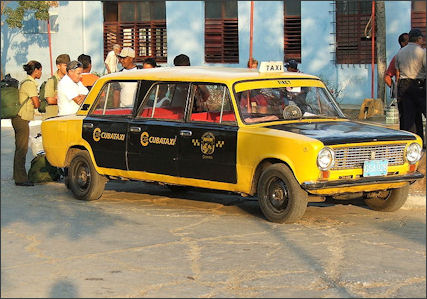
Lada Cuban taxiFor automobile owners their car is often their most treasured possession. For people without cars, a car is often the thing they want most. High status men are often the truck drivers and shared taxi drivers.
Gasoline is often sold on the streets in old plastic 2-liter soft drink bottles. People wash their vehicles in rivers.
It is not unusual to see a cars driving on the sidewalk or sweeping across five lanes of traffic to make a quick turn or driving in reverse along a narrow shoulder. If a driver misses his exit or drives past his destination — even if it is a half mile back on busy street — sometimes he will start driving backwards instead of finding a place to turn around.
Many drivers act like they are only ones on the road and often make life miserable for others to gain a slight advantage by, for example, by speeding up if someone tries to pass them or blocking the way so nobody can get past them.
One diplomat told the Washington Post, "I think driving reflects a society." In some countries "there is no established social contract. People do not believe that if they give up something to the general good, everyone can benefits. They believe that if they do not cut you off [in traffic], you will cut them off, and everyone is pushing for the maximum advantage all the time.”
Drivers have many bad habits, including grinding gears, accelerating too fast, driving too fast and recklessly, turning suddenly without signaling, speeding through intersections without slowing down, and steering all over the road. Some Chinese are very pushy, aggressive, inconsiderate and don't watch where they are going.
On rural roads, heavy trucks, buses and cars race towards oncoming traffic, forcing other vehicles onto the shoulders as they pass slower vehicles. Some drivers don't yield to pedestrians, don't yield to ambulances, park in such a way as to block traffic, oblivious the fact they are in other people's way. They drive slow in situations when they should be driving fast and drive fast when they should be driving slow. Kids often run out in the street without looking where they are going.
City Driving
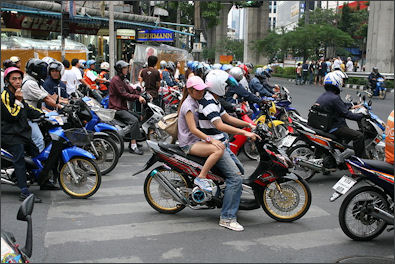
Motorbikes in Bangkok In the cities the streets are clogged with bicycles, motorbikes, cars, buses and carts. In heavy traffic it is not uncommon for impatient motorists to pull into a bicycle lane to make progress forward. Pedestrians are notorious for jaywalking disobeying walk signals. At intersections traffic officers sit in booths and switch the traffic lights by hand and shout insults at offenders out the window. In Shanghai, 2,000 unemployed people were hired to keep pedestrians in line at major intersections.
When driving in Third World cities watch out for people who: 1) drive on the sidewalk; 2) suddenly sweep across lanes of traffic to make a quick turn; 3) drive in reverse to back up to a missed turn; 4) drive with their parking lights instead of headlights at night; 5) pass on the inside lanes; 6) squeeze in three cars abreast in two lanes; 7) drive the wrong way down one way streets; and 7) run red lights and stop signs.
Driving Customs: 1) Cars making a right hand turns sometimes act as if they have the right of way over people that are driving straight. Often people turn into traffic without even looking to see if there is any traffic coming. 2) Drivers suddenly stop, slow down and pull over. One reason for this is that the address system in China is very confusing and drivers are often lost and looking around for a landmark. Chinese streets don't have names and people usually don't carry maps.
3) Some Chinese turn their engine off and shift into neutral when going downhill to save gas, and turn their lights off at night whenever they stop at a traffic light or stop sign. as a courtesy to other drivers. 4) If two cars meet on a narrow road and are unable to pass sometimes the drivers sit and stare each other down because shifting into reverse is regarded as a loss of face. 5) Motorist who judged responsible for a fatal traffic accident are often locked up in jail until they pay off the family of the person killed.
Honking Horns
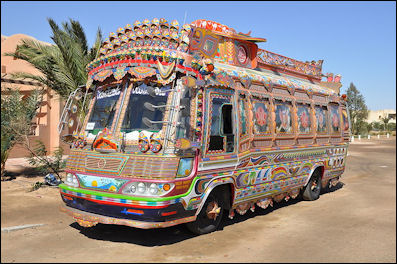
El Gouna Bus in Egypt Drivers honk their horns a lot. And often the louder the horn the better. There are businesses in many cities that specialize in removing the honking device from cars and replacing them with ones that are twice as loud.
Taxi drivers are particularly notorious for their honking. So there noise stands out, some install special horns that sound like crying babies, barking dogs, crowing roosters or mooing cows.
Describing the fondness for honking, John Daniszweski wrote in the Los Angeles Times, "How do they honk? Let us count the ways. They honk to warn pedestrians to stand back, or to pass another car, or if another car is veering close to them. They toot defensively coming into intersections. They toot while stuck in traffic jams, which is most of the time...If they drive taxis, they beep for their supper. If they just got married or if their team won a soccer match, they honk for sheer joy — even at 2:00am. If they want a mango juice or a newspaper, they beckon the street vendor with a friendly honk."
Road Accidents
Worldwide road accidents kill 1.2 million people a year, or about 3,000 a day. This is more than the number who from malaria and slightly less than those who die from tuberculosis. In addition, for every one death there are about 20 serious injuries. Nine out of every ten road fatalities occur in the developing world.
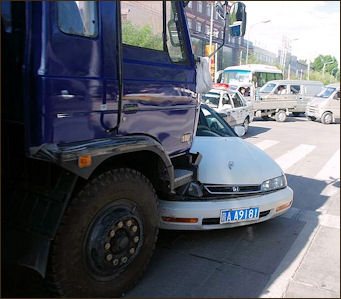
road accident in China Road and pedestrian accidents are on course to overtake HIV/AIDS as the leading cause of death and disability among children aged five to 14 according to the Commission of Global Road Safety. Foreign aid often goes to pay for construction of roads that are rarely designed with pedestrians in mind and generally don’t have sidewalks or crash barriers. In 1982, the World Bank recommended that five to 10 percent of the funding for new road be spent on safety measurers. In reality only 1.7 percent is (this figure is derived by how much Britain’s aid agency spends on road safety).
David Ward, director-general of the FIA Foundation and author of a report on road safety wrote: “New roads can make a bad situation much worse by raising the speed and volume of traffic while doing nothing to protect pedestrians and other vulnerable road users.”
Image Sources: Wikimedia Commons
Text Sources: New York Times, Washington Post, Los Angeles Times, Times of London, Yomiuri Shimbun, The Guardian, National Geographic, The New Yorker, Time, Newsweek, Reuters, AP, Lonely Planet Guides, Compton’s Encyclopedia and various books and other publications.
Last updated January 2012
